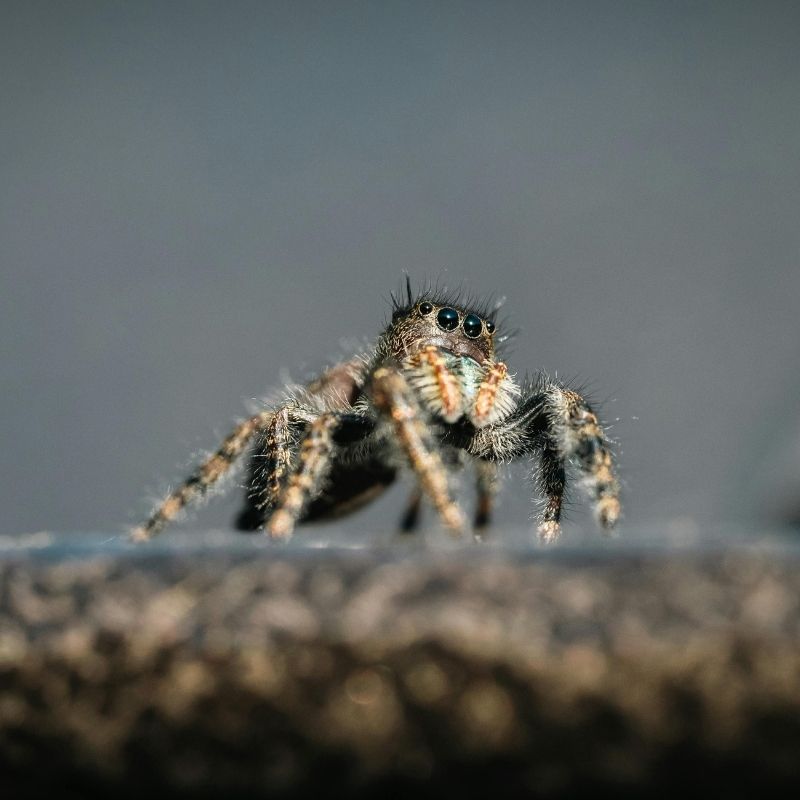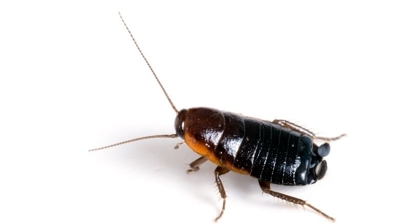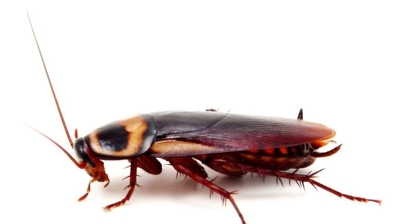
Jumping Spider Control Services

Jumping Spiders
Jumping spiders (Salticidae) are not generally considered dangerous to humans, and their potential harm is minimal compared to many other types of spiders. However, there are a few factors to consider:
- Venom: Jumping spiders do possess venom, but their venom is primarily used for subduing their prey, which mainly consists of insects. Their venom is not harmful to humans, and a bite from a jumping spider is usually no worse than a mosquito bite. In most cases, it causes mild, temporary discomfort such as itching or a minor, localized allergic reaction.
- Defensive Behavior: While jumping spiders are not aggressive, they may bite if they feel threatened or cornered. This is a last resort for them, and they will typically avoid humans when possible. Bites are rare, and the effects are usually minor.
- Allergies: In some rare instances, individuals may be hypersensitive or allergic to jumping spider venom, which can lead to more severe reactions. Such cases are exceedingly rare and should be treated as a medical emergency. Most people will not experience such an extreme reaction.
- Psychological Impact: For some people, the presence of any spider, including jumping spiders, may trigger fear or arachnophobia, causing psychological distress. While this is not a direct danger, it can be distressing to individuals who fear spiders.
Jumping spiders are, in fact, beneficial creatures in the environment as they help control insect populations. Their potential danger to humans is minimal and should not be a significant cause for concern. If you encounter a jumping spider, it is generally best to leave it alone or gently guide it outside if it's indoors.
Learn more: Do Jumping Spiders Bite? || Are Jumping Spiders Venomous? || What Do Jumping Spiders Eat?
Jumping Spider Removal
Jumping spiders are impressive predators, but there are several reasons homeowners sometimes prefer to keep them out of living spaces. They move quickly, can appear unexpectedly, and their sudden leaps can startle people—especially children or those with spider-related anxieties. Indoors, they tend to hide in window frames, ceiling corners, and cluttered areas, which makes them difficult to monitor and increases the chance of unwanted encounters.
Although they aren’t aggressive, they will bite if trapped against the skin. Their bites are usually mild, but for individuals with sensitivities, even a minor reaction can be unpleasant. More importantly, their presence often signals an underlying issue: abundant insect activity in or around the home. Jumping spiders establish themselves where food sources are reliable, so spotting them frequently can indicate gaps in exclusion, entry points around the structure, or conditions attracting other pests.
Removing them is less about eliminating a threat and more about restoring a controlled, clean environment. Keeping them out helps reduce surprises, improves comfort, and ensures that any underlying pest pressures are addressed rather than masked by natural predators. For many homeowners, our professional removal coupled with prevention offers peace of mind and reinforces good overall pest management.
Learn more: How To Get Rid Of Jumping Spiders
Jumping Spider Control
Hiring our professional pest control for jumping spiders is a smart choice when you want thorough, safe, and lasting protection for your home or business. While jumping spiders are not typically aggressive or dangerous, their presence can still be unsettling and may indicate other pest activity attracting them indoors. Our professional pest control services provide a more strategic and comprehensive solution than DIY efforts for several key reasons:
- Accurate Identification and Assessment: Jumping spiders can easily be mistaken for other species, including those that may be more harmful, such as black widows or wolf spiders. Our licensed pest control technician accurately identifies the species, determines the extent of the problem, and identifies environmental factors—such as other insect infestations—that may be attracting them.
- Targeted, Effective Treatments: Over-the-counter sprays and traps offer only temporary results and can even scatter spiders into new areas of your property. Our professionals use specialized products and treatment methods designed to reach hidden harborages where spiders nest, hunt, or lay eggs—delivering long-term control without overusing chemicals.
- Integrated Pest Management (IPM): Our professionals don’t just kill the spiders; we address the underlying causes of the infestation. Jumping spiders are attracted to areas with abundant insect prey. Our pest control experts will inspect for and eliminate other pest populations (like flies or ants), remove webs, seal entry points, and recommend exclusion and sanitation measures that prevent re-infestation.
- Safety and Expertise: Even though jumping spiders are not venomous to humans, improper pesticide use can put your family, pets, and property at risk. Our professionals apply EPA-approved materials safely and precisely, minimizing exposure while maximizing results.
- Lasting Prevention and Peace of Mind: Our professional pest control plans ensures ongoing protection. Regular inspections and preventative treatments stop future spider problems before they start, maintaining a cleaner, more comfortable, and pest-free environment year-round.
Hiring our professional pest control service to handle jumping spiders ensures expert diagnosis, safe treatment, and long-term prevention—protecting your property and peace of mind from recurring infestations.
Jumping Spider Exterminators
Choosing our local exterminators over a national company delivers clear advantages when dealing with something as specific and behavior-driven as a jumping spider problem. Our local professionals work daily within the same climate, building styles, and seasonal pest patterns that affect your property. That firsthand familiarity means we can pinpoint entry points, environmental conditions, and structural vulnerabilities faster and with greater accuracy than large companies applying broad, standardized protocols can.
You also gain the benefit of service that’s more attentive, responsive, and consistent. Our local exterminators rely on our reputation within the community, so you’ll work directly with an experienced technician who knows your home’s history and tailors our treatments accordingly. Instead of rotating staff and rigid, standardized service plans, you get personalized strategies designed to reduce both current spider activity and the underlying insect pressures that attract them.
Our local team spends more time inspecting, explaining findings, and following up. That thoroughness matters with jumping spiders because long-term success depends on eliminating micro-entry points, adjusting outdoor conditions, and addressing prey insects—not just applying a one-size-fits-all chemical treatment. We also provide more flexible scheduling, quicker emergency response, and stronger accountability if you need adjustments or additional visits.
Our local exterminators deliver precision, consistency, and community-driven service that a national brand can’t match—all of which translates into faster resolution, better prevention, and a more dependable overall experience.
What Do Jumping Spiders Look Like?
Jumping spiders (Family Salticidae) exhibit a wide range of appearances, but they share some common characteristics that can help you identify them. Here is a detailed description of what jumping spiders typically look like:
- Size: Jumping spiders are generally small to medium-sized spiders, with most species ranging from 1 to 25 millimeters in length. Some larger species can reach up to 30 millimeters.
- Body Shape: They have a compact and robust body shape with a distinct division between the cephalothorax (the front part) and the abdomen (the rear part). This gives them a somewhat squat appearance compared to other spider families.
- Eyes: Jumping spiders are known for their exceptional vision, and their eyes are a distinctive feature. They have a total of eight eyes arranged in three rows on the front of their cephalothorax. The most prominent pair of eyes, the anterior median eyes, is large and forward-facing, giving them excellent binocular vision for hunting.
- Coloration and Markings: Jumping spiders can display a wide range of colors and patterns, which can vary greatly between species. Many are adorned with vibrant colors, intricate patterns, and iridescent scales, making them visually striking. Common colors include black, brown, gray, and various shades of red, yellow, or green.
- Legs: They have eight relatively short and stout legs, which are often covered in fine hairs. These hairs can be important for sensory perception and anchoring silk threads during jumps.
- Chelicerae: The chelicerae are the two front appendages that house the spider's fangs. In jumping spiders, these are often relatively large and visible, but they are not as pronounced as in some other spider families.
- Pedipalps: These are the small, leg-like appendages located in front of the first pair of legs. In males, pedipalps can be modified for mating, and their structure can vary between species.
- Abdomen: The abdomen of jumping spiders tends to be rounded or oval-shaped, and its coloration and markings can also vary widely.
While these are common characteristics of jumping spiders, there is considerable diversity within the family, so not all jumping spiders will look exactly the same. Additionally, their striking colors and patterns can make them visually appealing and easily distinguishable from other spider families. Their remarkable eyesight, agility, and unique hunting behavior further set them apart from other arachnids.
Where Are Jumping Spiders Found?
Jumping spiders are highly adaptable and can be found in various locations in and around your home. These spiders are known for their curiosity and excellent hunting abilities, which can bring them into close proximity with humans. Here are common places where you might encounter jumping spiders around your home:
- Indoors: Jumping spiders are often seen on windowsills, where they may be hunting insects attracted to light. They can be found crawling on walls and ceilings, especially in well-lit areas. Jumping spiders may occasionally take refuge on indoor plants, where they hunt for insects.
- Outdoors: Jumping spiders are commonly found in gardens and outdoor vegetation, including flowers, shrubs, and trees. They use plants as hunting grounds for insects. They may occasionally wander onto patios and porches, especially if there are outdoor lights attracting insects. Jumping spiders can be seen on fences, walls, and other outdoor structures. In outdoor environments, they may seek shelter under leaves, rocks, or other debris during the day.
- Garages and Sheds: Jumping spiders can make their way into garages and sheds, where they may hunt insects and find shelter.
- Basements and Attics: In some cases, jumping spiders may enter the basement or attic through gaps or cracks. However, they are less common in these areas compared to other spiders like cellar spiders.
- Windows and Doors: They can enter your home through gaps around windows and doors, especially if there are outdoor lights attracting insects near entry points.
- Light Fixtures: Occasionally, jumping spiders may find their way into light fixtures, which can attract insects. You might spot them when changing light bulbs.
- Crawl Spaces: If your home has a crawl space, jumping spiders may venture into these areas.
Jumping spiders are generally harmless and pose no significant threat to humans. In fact, many people find their presence beneficial, as they help control insect populations around the home. If you encounter a jumping spider indoors and wish to relocate it outside, you can gently capture it with a container and a piece of paper, being careful not to harm it, and release it in a suitable outdoor location.
Jumping Spider Life Cycle
The life cycle of jumping spiders, like that of most spiders, involves several distinct stages from egg to adult. Jumping spiders exhibit interesting behaviors and characteristics throughout their life cycle. Here's a description of the typical life cycle of jumping spiders:
- Egg Stage: The life cycle begins when a female jumping spider lays a clutch of eggs. She may construct a silk egg sac to protect and camouflage the eggs. Jumping spiders are known for their diverse maternal behaviors, and some species guard their egg sacs, often carrying them around or attaching them to their shelter.
- Spiderling Stage: After an incubation period that varies by species and environmental conditions, the eggs hatch into spiderlings. Spiderlings are miniature versions of adult jumping spiders. Initially, spiderlings remain close to the egg sac and rely on a yolk sac for nutrition. As they grow, they undergo several molts, shedding their exoskeletons to accommodate their increasing size.
- Juvenile Stage: As spiderlings continue to grow and develop, they enter the juvenile stage. During this phase, they resemble adult jumping spiders but are smaller and lack full reproductive capabilities. Juvenile jumping spiders are often seen exploring their surroundings, honing their hunting skills, and practicing their jumping abilities.
- Mature Adult Stage: The duration of the juvenile stage can vary among species, but eventually, the spider reaches sexual maturity and becomes an adult. Adult jumping spiders are fully developed and capable of reproduction. They have all the distinctive features of the species, including their characteristic coloration and markings.
- Reproduction: Mating in jumping spiders typically involves elaborate courtship rituals. These rituals can vary significantly between species but often include visual displays, vibrations, and sometimes even vocalizations. Once a successful mating occurs, females may lay a new clutch of eggs, starting the life cycle anew.
- Behavior and Survival: Throughout their life cycle, jumping spiders exhibit remarkable hunting skills, using their keen eyesight to stalk and pounce on prey. Some species are known for their complex behaviors, including territoriality and interactions with other spiders.
- Lifespan: The lifespan of jumping spiders varies depending on the species and environmental factors. Typically, they live for several months to a few years, with females often having longer lifespans than males.
There is considerable variation in the life cycles and behaviors of jumping spider species. Some species may exhibit unique adaptations or behaviors specific to their habitat or ecological niche. Additionally, their life cycles can be influenced by factors such as temperature, prey availability, and reproductive strategies, making them a fascinating subject of study for researchers interested in spider biology and behavior.

Hear From Our Happy Customers
-
"Exceeds Expectations"
I can’t say enough positive things about this company... The tech that came out, Jarvis went above and beyond my expectations. Thank you guys, I will continue using your services.
- Jake M. -
"Great Communication"
Tech was on time, communication was great, and he accommodated my needs.
- Alonzo W. -
"Professional & Considerate"
I’m pleased with Miche services. Jarvis came today. Professional and considerate. Thank you!
- Judy B. -
"Very Knowledgeable"
The tech that arrived was courteous, professional, and very knowledgeable. He was Great.
- Uerial I. -
"Wonderful Service"
Wonderful service. Jarvis is great. Took care of everything I needed. Thank you!
- Henry P. -
"Fantastic & Patient"
Jarvis was fantastic and patient. He answered my questions with an in-depth explanation and addressed all of my areas of concern. Would love for him to be my assigned tech going forward. Well done!
- Yonnette M.



